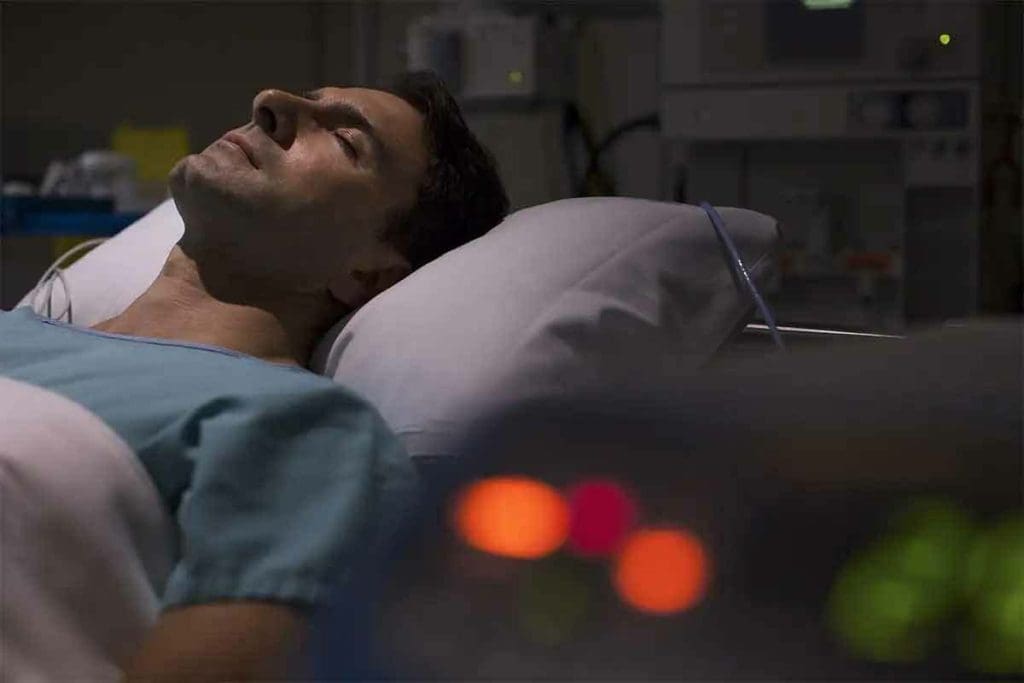Last Updated on November 27, 2025 by Bilal Hasdemir

Knowing what blood on a CT scan looks like is key for quick diagnosis and treatment of brain emergencies. At Liv Hospital, we stress the need for fast and accurate diagnosis. Blood shows up as a bright white on a CT scan, standing out against normal brain tissue, mainly in urgent cases.
A brain hemorrhage is bleeding in the brain, a serious issue that needs immediate care. We use CT scans to spot bleeding and help start treatment right away.
Key Takeaways
- Understanding CT scan results is critical for diagnosing neurological emergencies.
- Blood appears as a bright white area on a CT scan due to its hyperdense nature.
- CT scans are essential for detecting brain hemorrhages and guiding treatment.
- Accurate diagnosis is key for timely and effective treatment.
- Liv Hospital is dedicated to providing top-notch and reliable diagnostics.
The Basics of Brain CT Imaging

To understand CT scan images of the brain, we need to know how they are made. Computed Tomography (CT) scans use X-rays to create detailed images of the brain. These images help doctors diagnose many medical conditions.
How CT Scans Create Brain Images
CT scans rotate an X-ray source and detectors around the head. They capture data that is then turned into images. This method lets us see different brain structures and find problems.
Density Measurements: The Hounsfield Scale
The Hounsfield scale is key in CT imaging. It measures the density of tissues. It gives numbers to materials based on their density, from -1000 (air) to +1000 (bone), with water at 0. Knowing this scale is vital for reading head CT scans right, as it helps spot different tissues and problems.
A normal CT scan of the brain shows symmetrical structures and clear gray-white differences. The Hounsfield scale helps us measure these differences. This gives doctors important info for making diagnoses.
What Color Is Blood on a CT Scan

Acute blood on a CT scan looks very different. It’s important for doctors to know what it looks like. Acute blood is usually very bright white because it’s denser than brain tissue.
Hyperdense Appearance of Acute Blood
Acute blood looks bright white on a CT scan because of its high hemoglobin content. This makes it stand out against the brain. It’s key in emergency situations to spot bleeding quickly.
This bright white color helps us spot strokes and bleeding in the brain fast. It lets us make quick decisions to help our patients.
Factors Affecting Blood Visualization
But, how blood looks on a CT scan can change. The age of the blood is a big factor. Older blood might look the same as brain tissue, making it harder to see.
Other things like anemia or medical devices can also change how blood looks. The CT scanner settings can too. Knowing these can help us read CT scans better.
By understanding these points, we can better diagnose and treat patients with bleeding issues.
Characteristics of a Normal Brain CT Scan
Knowing what a normal brain CT scan looks like is key to spotting problems. A normal scan shows all the brain’s parts clearly. This is vital for making the right diagnosis.
Normal Anatomical Structures
A normal brain CT scan shows symmetrical brain parts. We should see the cerebral hemispheres, cerebellum, and brainstem clearly. The symmetry of these parts is a sign of a healthy scan.
Gray-White Matter Differentiation
Another important thing is seeing gray and white matter clearly. Gray matter is denser because it has more cells. This helps doctors check if the brain is okay.
Ventricular System and CSF Spaces
The ventricular system, like the lateral and third ventricles, should look symmetrical. The cerebrospinal fluid (CSF) spaces, like the sulci and cisterns, should also be visible. The size and shape of these areas can hint at any issues.
To better understand a normal brain CT scan, let’s look at this table:
| Feature | Normal Appearance on CT Scan |
| Anatomical Structures | Symmetrical cerebral hemispheres, cerebellum, and brainstem |
| Gray-White Matter | Clear differentiation, with gray matter appearing denser |
| Ventricular System | Symmetrical ventricles, normal size |
| CSF Spaces | Normal sulci and cisterns, without excessive enlargement |
Understanding these features helps doctors spot problems and make accurate diagnoses.
Features of a Healthy Brain CT Scan
Understanding brain CT scans is key. A healthy scan shows certain features. These help doctors tell it apart from an abnormal one.
Symmetry and Midline Structures
One important sign is brain structure symmetry. The midline structures, like the falx cerebri and septum pellucidum, must align perfectly. Any misalignment could mean a problem.
Experts say, “The midline should be clearly visible and not shifted. This could be a sign of a mass effect or other serious conditions.”
Normal Density Patterns
A normal scan shows different tissue densities. Gray matter and white matter should be easy to tell apart. Gray matter looks denser than white. The Hounsfield scale measures this density.
Age-Related Normal Variations
Age affects brain scans too. Older people might show brain atrophy, which is normal. Knowing this helps avoid mistaking normal changes for disease.
Doctors need to know these signs to read brain CT scans right. A healthy scan is vital for diagnosing and treating brain issues.
“Understanding the normal appearance of a brain CT scan is fundamental to identifying abnormalities and providing appropriate patient care.”
” Expert in Neuroradiology
Types of Intracranial Hemorrhage on CT Images
Intracranial hemorrhage shows up in different ways on CT images. Knowing these differences is key for correct diagnosis and treatment.
Blood can appear in areas like epidural, subdural, intraparenchymal, intraventricular, or subarachnoid spaces. The location and look of the blood on CT scans tell us a lot about its type and cause.
Epidural Hematoma: Biconvex Shape
An epidural hematoma looks like a biconvex or lens-shaped collection on CT images. It usually happens because of a head injury that causes bleeding between the dura mater and the skull.
The biconvex shape is due to the dura’s tight hold on the skull, limiting blood spread. Epidural hematomas are often linked to skull fractures and can cause serious problems if not treated quickly.
Subdural Hematoma: Crescent Shape
A subdural hematoma looks like a crescent on CT scans. This is because the subdural space has more room for blood to spread, unlike the epidural space.
Subdural hematomas are more common in older people and those with brain atrophy. This is because there’s more space between the brain and skull for blood to collect before symptoms show.
Subarachnoid Hemorrhage: Cisterns and Sulci
Subarachnoid hemorrhage shows up as blood in the subarachnoid space, around the brain. On CT images, it looks like hyperdense material in the cisterns and sulci.
It’s often caused by an aneurysm rupture and can cause severe headaches. Quick diagnosis is important to avoid rebleeding and manage complications.
Intraparenchymal Hemorrhage: Brain Tissue Bleeding
Intraparenchymal hemorrhage is bleeding into the brain tissue. On CT scans, it shows as a hyperdense area in the brain, often with swelling around it.
This type of hemorrhage can come from high blood pressure, vascular malformations, or tumors. The size and location of the hemorrhage affect the patient’s outcome and treatment choices.
For more on intracranial hemorrhage and its treatment, check out the study on PMC. It offers insights into detecting and treating hemorrhages.
Evolution of Blood on a CT Scan Over Time
The way blood looks on a CT scan changes over time. Doctors need to know this to make accurate diagnoses. Blood’s look on a CT scan changes as it ages, showing different stages of bleeding.
Acute Phase: Bright White Appearance
In the first few days after bleeding, blood looks hyperdense or bright white on a CT scan. This is because fresh blood is very dense, full of hemoglobin. The acute blood on ct is easy to spot because of its clear look.
Subacute Phase: Density Changes
After 1-2 weeks, blood’s density on a CT scan starts to change. Hemoglobin in the blood breaks down, making it less dense. At this stage, the blood may look isodense, making it harder to see on the scan.
Chronic Phase: Isodense to Hypodense Transition
Months after bleeding, blood on a CT scan often looks hypodense, darker than the brain. This change shows the blood is breaking down and being absorbed. Knowing how chronic blood on ct looks is key to spotting old bleeds.
It’s vital for doctors and radiologists to understand how blood changes on CT scans over time. Knowing how blood goes from bright to dark helps them diagnose and treat bleeding problems better.
Systematic Approach to Reading Head CT Scans
Reading head CT scans needs a structured method. This way, we check all important areas well and don’t miss anything. A systematic approach also cuts down on mistakes and boosts accuracy.
The ABCDE Method of CT Interpretation
The ABCDE method is a key way to read head CT scans. It looks at the scan in a set order: A for Airway, B for Bones, C for CSF spaces, D for Dementia or brain issues, and E for Extra-axial spaces.A renowned neuroradiologist says this method greatly improves finding problems.
This method makes sure we check all key parts of the brain CT scan. By following this order, we can spot hemorrhages, fractures, or other issues well.
Critical Areas to Examine First
When we start reading a head CT scan, we should first look at key areas. These are the ventricles, basal cisterns, and the cerebral cortex. We look for signs of bleeding, swelling, or mass effect that could mean serious issues like bleeding in the brain or stroke.
By focusing on these areas first, we can quickly spot serious conditions that need quick action.
Comparing Right and Left Hemispheres
Another important step is to compare the right and left hemispheres for symmetry. This helps us find small issues that might not be obvious. Asymmetry can show many problems, from stroke to tumors.
By comparing both sides, we can better find problems and make more precise diagnoses.
Common Abnormal Findings on Brain CT Images
When we look at brain CT scans, finding odd things is key for the right diagnosis and treatment. These oddities can be many conditions that need quick medical help.
Mass Effect and Midline Shift
Mass effect is when a lesion or swelling pushes brain tissue out of place. This can cause a midline shift, where the brain’s middle parts move from their usual spot. How much the midline shifts tells us about the risk of brain herniation, a serious problem.
Clinical significance: Spotting mass effect and midline shift is vital. It helps us see if there’s a risk of herniation and if we need to act fast.
Cerebral Edema Patterns
Cerebral edema, or brain swelling, shows up in different ways on CT scans. There’s:
- Cytotoxic edema, linked to ischemic stroke
- Vasogenic edema, seen around tumors or abscesses
Knowing these patterns helps us figure out what’s causing the swelling.
Hydrocephalus and Ventricular Changes
Hydrocephalus is when too much cerebrospinal fluid (CSF) builds up in the ventricles, making them bigger. CT scans can show how big and shaped the ventricles are. This helps us spot hydrocephalus and track how it’s changing.
| Condition | CT Scan Findings |
| Hydrocephalus | Enlarged ventricles |
| Cerebral Edema | Hypodense areas around lesions |
| Mass Effect | Displacement of brain structures |
Ischemic Changes and Infarcts
Ischemic changes on CT scans can show early signs of stroke. Spotting these early is key for quick action. Infarcts look like dark spots on the scan, and we can see how big they are.
Key features: Look for loss of gray-white matter difference, dark spots in affected areas, and sulcal effacement. These are signs of ischemia.
Emergency Interpretation of Blood on CT Scans
Quick and accurate CT scan interpretation is key in emergency care. It helps spot serious bleeding issues fast. In the emergency room, CT scans are essential for checking patients with possible brain bleeding.
Time-Critical Hemorrhagic Conditions
Some bleeding issues need urgent care because they can get worse fast. These include:
- Epidural hematomas with big mass effect
- Subarachnoid hemorrhages showing vasospasm signs
- Intraparenchymal hemorrhages with high brain pressure signs
Rapid Assessment Techniques
We use a quick method to check CT scans in emergencies:
- Look at brain structure symmetry
- Check for midline shift or mass effect signs
- See how blood density looks to judge bleeding severity
Red Flags Requiring Immediate Action
When we read CT scans, we watch for urgent signs. These are:
- Big hematomas with big mass effect
- Hydrocephalus needing ventricular drainage
- Herniation signs showing brainstem danger
Spotting these urgent signs helps us act fast. This can help save lives and improve recovery chances.
Pitfalls in Brain CT Interpretation
Reading brain CT scans needs more than just knowing about the brain’s structure. It also requires spotting common mistakes that can lead to wrong diagnoses. Getting it right is vital for the right treatment.
Artifacts That Mimic Hemorrhage
One big challenge is telling real bleeding from fake signs of it on CT scans. Beam hardening artifacts can look like blood, even though they’re not. This happens because the skull absorbs X-rays differently, mainly in the back of the brain.
Partial volume averaging is another issue. It mixes the signals from two tissues in one spot, making it hard to tell what’s really there. Knowing about these tricks is key to making the right call.
| Artifact Type | Description | Potential Misinterpretation |
| Beam Hardening | Differential X-ray absorption by the skull | Hemorrhage in the posterior fossa |
| Partial Volume Averaging | Averaging density of different tissues | Hemorrhage or calcification |
Normal Variants Confused with Pathology
Some normal brain features can look like disease on CT scans. For example, uneven ventricles or different sulcal patterns might seem like brain shrinkage or swelling. Knowing these normal variations helps avoid mistakes.
“The key to accurate CT interpretation lies in understanding the spectrum of normal anatomy and its variations.”
” Expert Radiologist
Technical Factors Affecting Image Quality
Things like patient motion, bad window settings, or wrong reconstruction methods can mess up CT images. These issues can hide important details or create fake signs, leading to wrong diagnoses.
By knowing these common problems, doctors and radiologists can get better at diagnosing. This knowledge helps improve patient care. It’s all about staying informed and up-to-date with brain CT scans.
Advanced CT Techniques for Enhanced Brain Assessment
New CT techniques have greatly improved how we check the brain for problems. They give us detailed info we couldn’t get before. This has changed neuroradiology a lot.
CT Angiography for Vascular Evaluation
CT angiography is a key tool for seeing brain blood vessels clearly. It uses contrast agents to spot issues like aneurysms or blockages. This helps us plan treatments and check for stroke risks.
Experts say, “CT angiography is key for checking brain blood diseases” source.
CT Perfusion in Stroke Assessment
CT perfusion shows how blood flows in the brain. It’s great for finding ischemia or infarction quickly. This is very important for treating strokes fast.
It helps us see how much tissue is at risk. This guides our treatment choices.
“CT perfusion imaging has emerged as a vital component in the assessment of acute stroke, enabling clinicians to make informed decisions about thrombolytic therapy and other interventions.”
As noted by neuroradiology experts.
Dual-Energy CT Applications
Dual-energy CT can tell different materials apart better. This helps spot brain problems that regular CT might miss. It’s a big help in finding small issues.
As we keep improving in neuroradiology, these advanced CT methods will be even more important. They help us understand and treat brain issues better.
Conclusion
Understanding CT scans is key for spotting neurological emergencies. This is true, mainly when looking for blood on CT scans. We’ve covered the main points for reading CT scans. This includes knowing how blood looks on these images and spotting both normal and abnormal signs.
At Liv Hospital, we’re experts in neuroradiology. This skill helps us give quick and accurate diagnoses. These are vital for good patient care. By knowing how to spot blood on CT scans and using a systematic way to read images, doctors can make better choices. This helps improve patient results.
Keeping up with CT scan interpretation is important for healthcare workers. We stress the need for accurate CT scan reading. Expert care is also critical in neurological emergencies.
FAQ
What color is blood on a CT scan?
Blood looks bright white on a CT scan, mainly in the early stages. This is because fresh blood is denser than brain tissue.
How do you differentiate between normal and abnormal brain CT scans?
We check for symmetry and normal density patterns to tell if a scan is normal. Abnormal scans might show signs of bleeding, swelling, or lack of blood flow.
What are the characteristics of a normal brain CT scan?
A normal scan shows clear brain structures and symmetry. It has no signs of bleeding or swelling. This is what we look for.
How does the appearance of blood on a CT scan change over time?
Blood looks bright white at first but changes to less dense over time. This change happens as the blood ages.
What are the different types of intracranial hemorrhage visible on CT images?
There are several types of bleeding visible on CT scans. These include bleeding outside the brain, in the brain’s covering, in the brain’s spaces, and inside the brain tissue.
How do you read a head CT scan systematically?
We follow the ABCDE method. This means checking for bone, brain, and fluid space issues. We also look for bleeding or swelling and compare both sides.
What are some common abnormal findings on brain CT scans?
We often see swelling, fluid buildup, and signs of lack of blood flow. These can mean serious conditions that need quick medical help.
What are some pitfalls in interpreting brain CT scans?
Misinterpretations can happen due to artifacts or normal variations that look like problems. Knowing these can help avoid mistakes.
How do advanced CT techniques enhance brain assessment?
New CT methods like angiography and perfusion scans help us see more. They’re great for checking blood flow and vascular issues.
Why is understanding blood on CT scans important for diagnosing neurological emergencies?
Knowing how to spot blood on CT scans is key. It helps us quickly find and treat serious bleeding issues.
References
Heit, J. J., & others. (2016). Imaging of intracranial hemorrhage. PMC (PubMed Central). https://pmc.ncbi.nlm.nih.gov/articles/PMC5307932/






